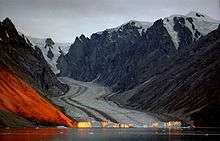Northeast Greenland National Park
| Northeast Greenland National Park | |
|---|---|
|
IUCN category II (national park) | |
 | |
| Location |
|
| Coordinates | 76°N 30°W / 76°N 30°WCoordinates: 76°N 30°W / 76°N 30°W |
| Area | 972,000 km2 (375,000 sq mi) |
| Established | 21 May 1974 |
Northeast Greenland National Park (Greenlandic: Kalaallit Nunaanni nuna eqqissisimatitaq, Danish: Grønlands Nationalpark) is the world's largest and most northerly national park.[1] Established in 1974 and expanded to its present size in 1988, it protects 972,001 km2 (375,000 sq mi)[2] of the interior and northeastern coast of Greenland and is bigger than all but twenty-nine countries in the world. It was the first national park to be created in the Kingdom of Denmark and remains Greenland's only national park.
Geography
The park shares borders, largely laid out as straight lines, with the Sermersooq municipality in the south and with the Qaasuitsup municipality in the west along the 45° West meridian on the ice cap in the west. The large interior of the park is part of the Greenland Ice Sheet, but there are also large ice-free areas along the coast and on Peary Land in the north.
The area is subject to larger loss of ice than expected.[3]
History
Originally created on 22 May 1974 from the northern, practically uninhabited part of the former Ittoqqortoormiit Municipality in Tunu (East Greenland), in 1988 the park was expanded by another 272,000 km2 (105,019.8 sq mi) to its present size, adding the northeastern part of the former county of Avannaa (North Greenland). In January 1977 it was designated an international biosphere reserve. The park is overseen by the Greenland Department of Environment and Nature. The historical research camps on the ice sheet−Eismitte and North Ice−fall within the boundaries of the present-day park.
Population

The park has no permanent human population. In 1986, the permanent population of the park was 40, living at Mestersvig, although 400 sites saw occasional summertime use. These 40 were involved in cleanup and closeout operations at mining exploration sites and soon left. Since then censuses have recorded zero permanent human population. Recently only 31 people and about 110 dogs were present over winter in North East Greenland, distributed among the following stations (all on the coast, except Summit Camp):[4][5]
- Daneborg (12) headquarters of the Sirius Patrol, the park policing agency
- Danmarkshavn (8) civilian weather station
- Station Nord (5) military base
- Mestersvig (2) military outpost with 1,800 m gravel runway
- Zackenberg (0) summer-only research station
- Summit Camp (4) research station on the Greenland Ice Sheet
During summer scientists add to these numbers. The research station ZERO (Zackenberg Ecological Research Operations) 74°28′11″N 20°34′15″W / 74.469725°N 20.570847°W can cater for over 20 scientists and station personnel.
Fauna
.jpg)
An estimated 5,000 to 15,000 musk oxen, as well as numerous polar bears and walrus, can be found near the coastal regions of the park. This is claimed to be 40% of the world population of musk ox.[6] Other mammals include Arctic fox, stoat, collared lemming and Arctic hare. Other marine mammals include ringed seal, bearded seal, harp seal and hooded seal as well as narwhal and Beluga whale.
Species of birds which breed in the park include great northern diver, barnacle goose, pink-footed goose, common eider, king eider, gyrfalcon, snowy owl, sanderling, ptarmigan and raven.
See also
References
- ↑ "The National Park". Greenland.com. Retrieved 2013-06-18.
- ↑ Statistics Greenland, Greenland in Figures, 2009
- ↑ Ramskov, Jens. "Climate models underestimate the melting of the ice cap " In English Ingeniøren, 26 December 2014. Accessed: 26 December 2014.
- ↑ "The Sirius Sledge Patrol". Destination EastGreenland. Retrieved 2008-10-03.
- ↑ NOAA Research
- ↑ "Kalaallit Nunaat high arctic tundra". Terrestrial Ecoregions. World Wildlife Fund. Retrieved 2008-10-03.
External links
| Wikimedia Commons has media related to Northeast Greenland National Park. |
- Main park webpage
- Image gallery
- UN website on park
- ZERO - Zackenberg Ecological Research Operations
- "Kalaallit Nunaat high arctic tundra". Terrestrial Ecoregions. World Wildlife Fund.
- Exploration History of Northeast Greenland
| ||||||||||
| ||||||||||||
| ||||||||||||||||||||||||||||||||||||||||||||||||||

